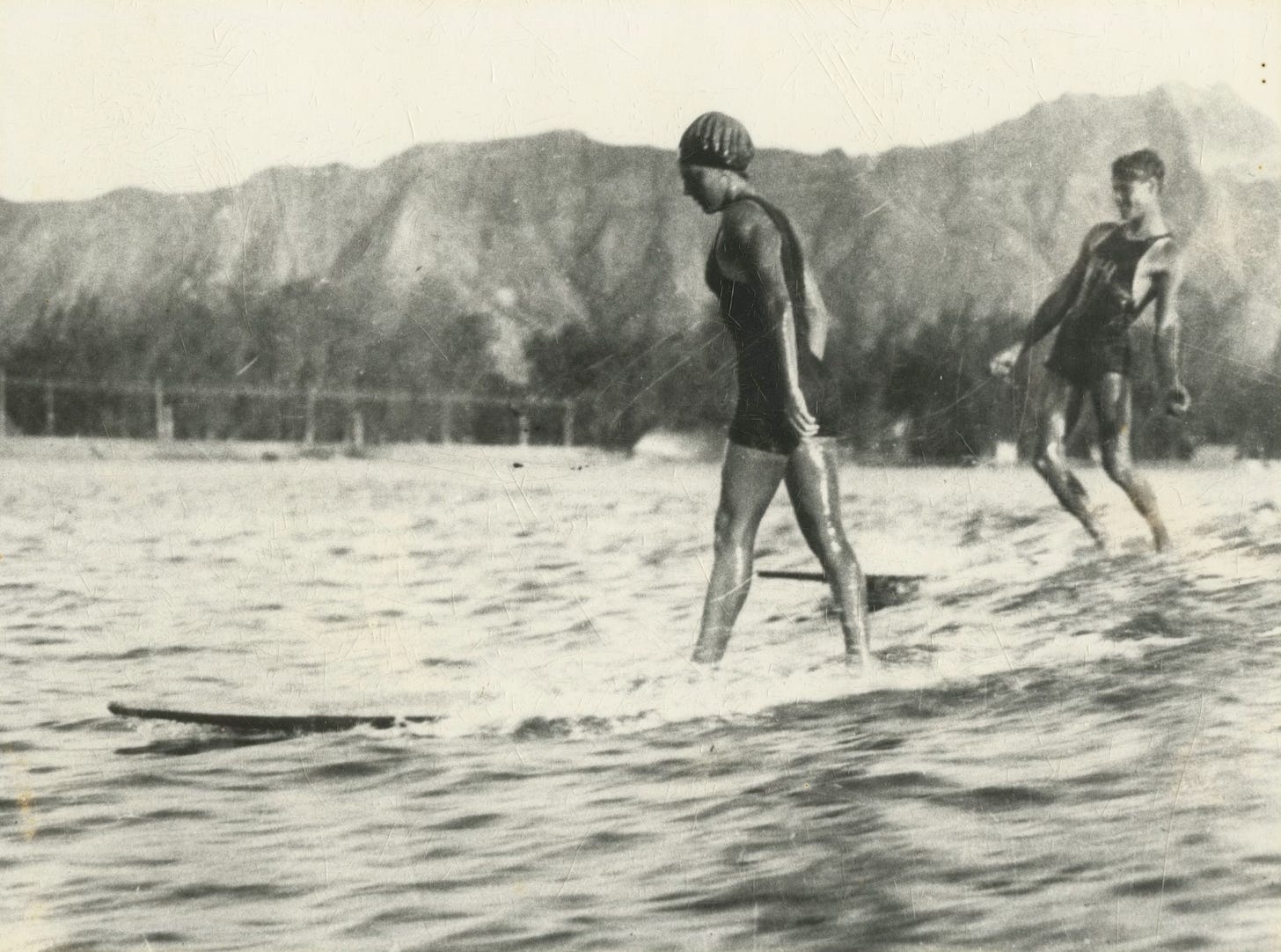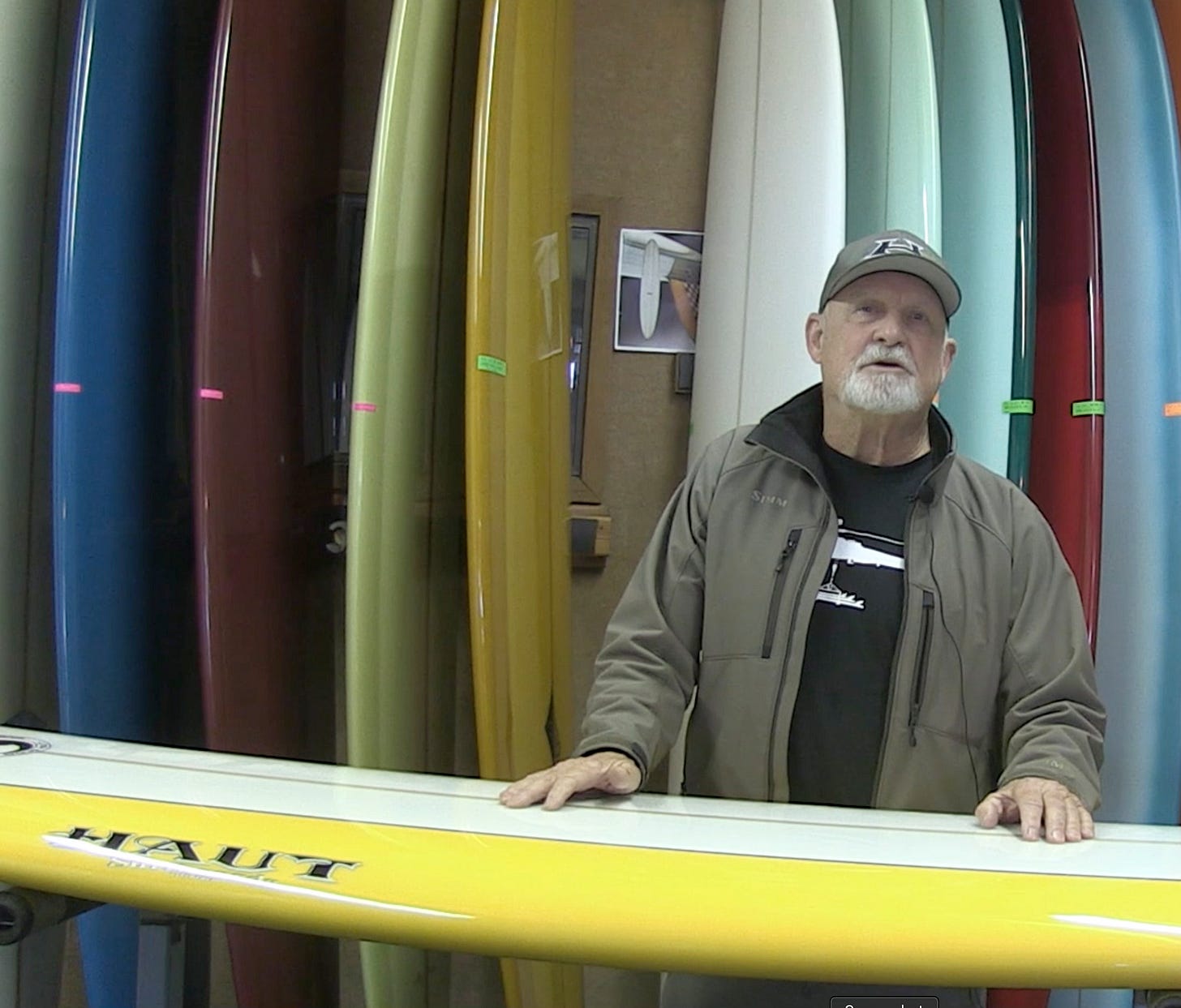Surfing's beginnings in California - Santa Cruz
Maui remains in a rebuilding process; we reached the 100 day mark this week. It’s a long process and nothing is ever the same again. Please send all the aloha you can to this part of paradise.
When I began working on “Addicted to Joy” I started in Santa Cruz. On the first day of filming, we were in Oceanside, California. We spent the next three days there, and besides the interviews I was conducting, I was also observing a culture that had fascinated me since I moved to California in 1980. As the project progressed, I could really see there were very distinct differences between the surfing communities of Orange County, Los Angeles County, and Santa Cruz. Later in the film’s production I also got very familiar with the Bolinas Community. In the next few posts, I’m going to detail these communities, which developed quite differently (no cell phones or social media), each with their own styles and stories.
Santa Cruz
The origin of surfing dates back to the 12th century when cave paintings of people balancing on planks in water were found in Polynesia. Soon, Polynesians brought the sport with them to Hawaii, where it was considered a religious ritual and only available to royalty. Akoni and Lyman Swan were employees of the Royal Family who had to leave the island because of charges of forgery and embellishment, and they landed in Santa Cruz. It was the Swan’s who hosted three Hawaiian princes—David Kawānanakoa, Jonah Kūhiō Kalaniana'ole, and Edward Keli'iahonui when they arrived in California in 1885. The boys were studying in nearby San Mateo at the strict Episcopalian Saint Matthews College. During summer break, the three Princes crafted redwood boards as they had been instructed back in Hawaii. Wood for these boards most likely came from the Grover Lumber company which was 4 blocks away. They dropped the boards in the San Lorenzo River and paddled the 4 blocks to the ocean. There was a swimming contest going on that day and the three boys created quite a sensation.
A few years later in 1896, the Santa Cruz Surf reported that, “the boys who go in swimming at Seabright Beach use surfboards to ride the breakers, like the Hawaiians.” We have to assume these were redwood boards, but quite possibly could have been plain planks of wood, possibly an ironing board sacrificed for this noble sport. A tiny community was born in Santa Cruz and was deeply connected to Hawaii. In 1915, Santa Cruz surfer Dorothy Becker was one of the first Americans to surf in Hawaii when she rode the waves at Waikiki.
At one time the old lighthouse at Steamer Lane was the Santa Cruz Surfing Museum. When I went there for research I found a very limited display and was told all of the records had been moved to the Santa Cruz Historical Society. I knew them from a past project and went for a visit. What I found was all the records in boxes under the stairs, but there was a treasure trove of photographs. I was allowed permisson to use the images if I went a gave them high resolution scans for the Museums archives. I signed releases and scanned away. About three years later I got a call and found out about the Santa Cruz Surfing Club and the collection that had been gathered by Henry Mayo. I was granted permission again if I credited the images, so when you see the credit, I am grateful to both parties involved in allowing me to show you these crazy cool photographs.
Surfing took off in the late 1930s in Santa Cruz when a group of locals formed the Santa Cruz Surfing Club. The surfers started venturing into the harsh waves of Cowell’s Beach.
Hobie Alter (surfboard shaper in Orange County) claimed that at one time, in the early 1950’s, there were only 250 surfers in all of California. The Santa Cruz surfers had the waves to themselves and lack of people wasn’t the only issue. In the winter the water temperature can reach the mid 40’s and in the summer the low 60’s. There is legend that Jack O’Neil invented the wet suit in 1952 to allow surfers to stay in the water longer, in truth Hugh Bradner, a University of California, Berkeley physicist, invented the modern wetsuit in 1952 - leave it to the scientists.
I need to stop here and go a little deeper into the early surfers. The original title of Addicted to Joy was Surfers and Shapers because of the direct relationship between being in the water and creating the sled for riding waves. There was no surfing industry, there were no surf shops, there wasn’t a fleet of surfboards to choose from. If you wanted to surf, you had to make your own board or find somebody to make it for you. Many of the individuals featured in ATJ are the originators of the sport, hence they became surfboard shapers. These are legendary names that grew and changed as the sport changed. In their careers, they created surfboards from redwood and balsa woods. When foam became available to the public after World War II, they pioneered how to take foam and create a surfboard from it. This all happened in 20 years, and surfing went from a deer trail in the woods to a ten lane super highway. No other sport has grown as large and evolved so quickly…back to your regularly scheduled program.
In the 1950s, Steamer Lane was considered one of the best training arenas for Makaha, the famous and thunderous Hawaiian surf break located on the North Shore of Oahu and the connection between Santa Cruz and Hawaii deepened. Part of that deepening connection was a surfer and surfboard shaper named Kenny Tilton. When I interviewed Kenny the first time, I found a warm and captivating person, and we became friends. During several interviews at Dave Sweet’s (of Santa Cruz) home in the Santa Cruz Mountains, Kenny told me his story of growing up in Hawaii, learning to shape surfboards with Donald Takayama, and traveling to the Mainland as a youth. Kenny shaped surfboards for Dale Kelsey, Donald Takayama and himself. Kenny left Santa Cruz because the water was too cold. Kenny’s interview in ATJ speaks for itself. Rest in Aloha Kenny, we’ll always have the Pepsi® challenge.
Another shaper in Santa Cruz from the beginning is Doug Haut. Doug is still shaping today and he started surfing the waves in Santa Cruz in 1957. Doug is truly one of the nicest human beings on the planet and his interview was right on point. Again, a pioneer who has grown to legendary status, if you have a Haut board, you have a treasure.
These are the breaks in the area, Cowell's, Capitola Jetty, Steamer Lane, Pleasure Point, Manresa State Beach, The Hook, 30th and East Cliff, Natural Bridges, Four Mile, and of course Mavericks. If are new to the area, you should always respect the locals and know your abilities. The waves can be huge. Always know the conditions and listen to any Lifeguard or safety person who you see.
Next time, LA County.







